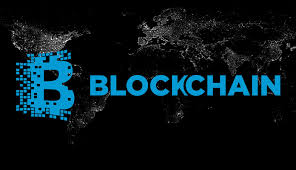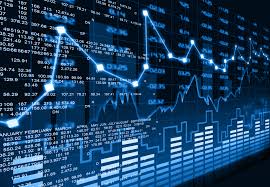The Blockchain!
Am Facinated on how the Blockchain Works and i think its best to break it down to those that who are still hearing it for the first time.
.jpg)
A blockchain[1][2][3] – originally block chain[4][5] – is a distributed database that maintains a continuously growing list of ordered records called blocks. Each block contains a timestamp and a link to a previous block.[6] By design, blockchains are inherently resistant to modification of the data — once recorded, the data in a block cannot be altered retroactively. Through the use of a peer-to-peer network and a distributed timestamping server, a blockchain database is managed autonomously. Blockchains are "an open, distributed ledger that can record transactions between two parties efficiently and in a verifiable and permanent way. The ledger itself can also be programmed to trigger transactions automatically."[7]
.jpg)
Blockchains are secure by design and an example of a distributed computing system with high byzantine fault tolerance. Decentralised consensus can therefore be achieved with a blockchain.[8] This makes blockchains suitable for the recording of events, medical records,[9][10] and other records management activities, identity management,[11][12][13] transaction processing, and proving data provenance.
.jpg)
The first blockchain was conceptualised by Satoshi Nakamoto in 2008 and implemented the following year as a core component of the digital currency bitcoin, where it serves as the public ledger for all transactions.[1] The invention of the blockchain for bitcoin made it the first digital currency to solve the double spending problem, without the use of a trusted authority or central server. The bitcoin design has been the inspiration for other applications.[1][3]
The first work on a cryptographically secured chain of blocks was described in 1991 by Stuart Haber and W. Scott Stornetta, followed by publications in 1996 by Ross J. Anderson and 1998 by Bruce Schneier and John Kelsey.[14] In parallel, Nick Szabo was working in 1998 on a mechanism for a decentralized digital currency that he called bit gold.[15] In 2000 Stefan Konst published a general theory for cryptographic secured chains and suggested a set of solutions for implementation.
The first blockchain was then conceptualised by Satoshi Nakamoto in 2008 and implemented the following year as a core component of the digital currency bitcoin, where it serves as the public ledger for all transactions.[1] Through the use of a peer-to-peer network and a distributed timestamping server, a blockchain database is managed autonomously. The invention of the blockchain for bitcoin made it the first digital currency to solve the double spending problem. The bitcoin design has been the inspiration for other applications.[1][3]
The blockchain format was first used for bitcoin, as a solution to the problem of making a database both secure and not requiring a trusted administrator.[4] The words block and chain were used separately in Satoshi Nakamoto's original paper in October 2008,[16] and when the term moved into wider use it was originally block chain,[4][5] before becoming a single word, blockchain, by 2016. In August 2014, the bitcoin blockchain file size reached 20 gigabytes.[17] In January 2015, the size had grown to almost 30 gigabytes, and from January 2016 to January 2017, the bitcoin blockchain grew from 50 gigabytes to 100 gigabytes in size.[18]
By 2014, "Blockchain 2.0" was a term referring to new applications of the distributed blockchain database.[19] The Economist described one implementation of this second-generation programmable blockchain as coming with "a programming language that allows users to write more sophisticated smart contracts, thus creating invoices that pay themselves when a shipment arrives or share certificates which automatically send their owners dividends if profits reach a certain level."[1] Blockchain 2.0 technologies go beyond transactions and "exchange of value without powerful intermediaries acting as arbiters of money and information". They are expected to enable excluded people to enter the global economy, enable the protection of privacy and people to "monetize their own information", and provide the capability to ensure creators are compensated for their intellectual property. Second-generation blockchain technology makes it possible to store an individual's "persistent digital ID and persona" and are providing an avenue to help solve the problem of social inequality by "[potentially changing] the way wealth is distributed."[20]:14–15 As of 2016, Blockchain 2.0 implementations continue to require an off-chain oracle to access any "external data or events based on time or market conditions [that need] to interact with the blockchain."[21]
In 2016, the central securities depository of the Russian Federation (NSD) announced a pilot project based on the Nxt Blockchain 2.0 platform in order to explore the use of blockchain-based automated voting systems.[22] Various regulatory bodies in the music industry have started testing models that use blockchain technology for royalty collection and management of copyrights around the world.[23][better source needed] IBM opened a blockchain innovation research centre in Singapore in July 2016.[24] A working group for the World Economic Forum met in November 2016 to discuss the development of governance models related to blockchain.[25] According to Accenture, an application of the diffusion of innovations theory suggests that in 2016 blockchains attained a 13.5% adoption rate within financial services, therefore reaching the early adopters phase.[26] In 2016, industry trade groups joined to create the Global Blockchain Forum, an initiative of the Chamber of Digital Commerce.[27]
Copied from Wikipedia...
Blog by andy....
Pease follow and upvote blog....
Hi! I am a robot. I just upvoted you! I found similar content that readers might be interested in:
https://www.isnare.com/encyclopedia/Blockchain_(database)